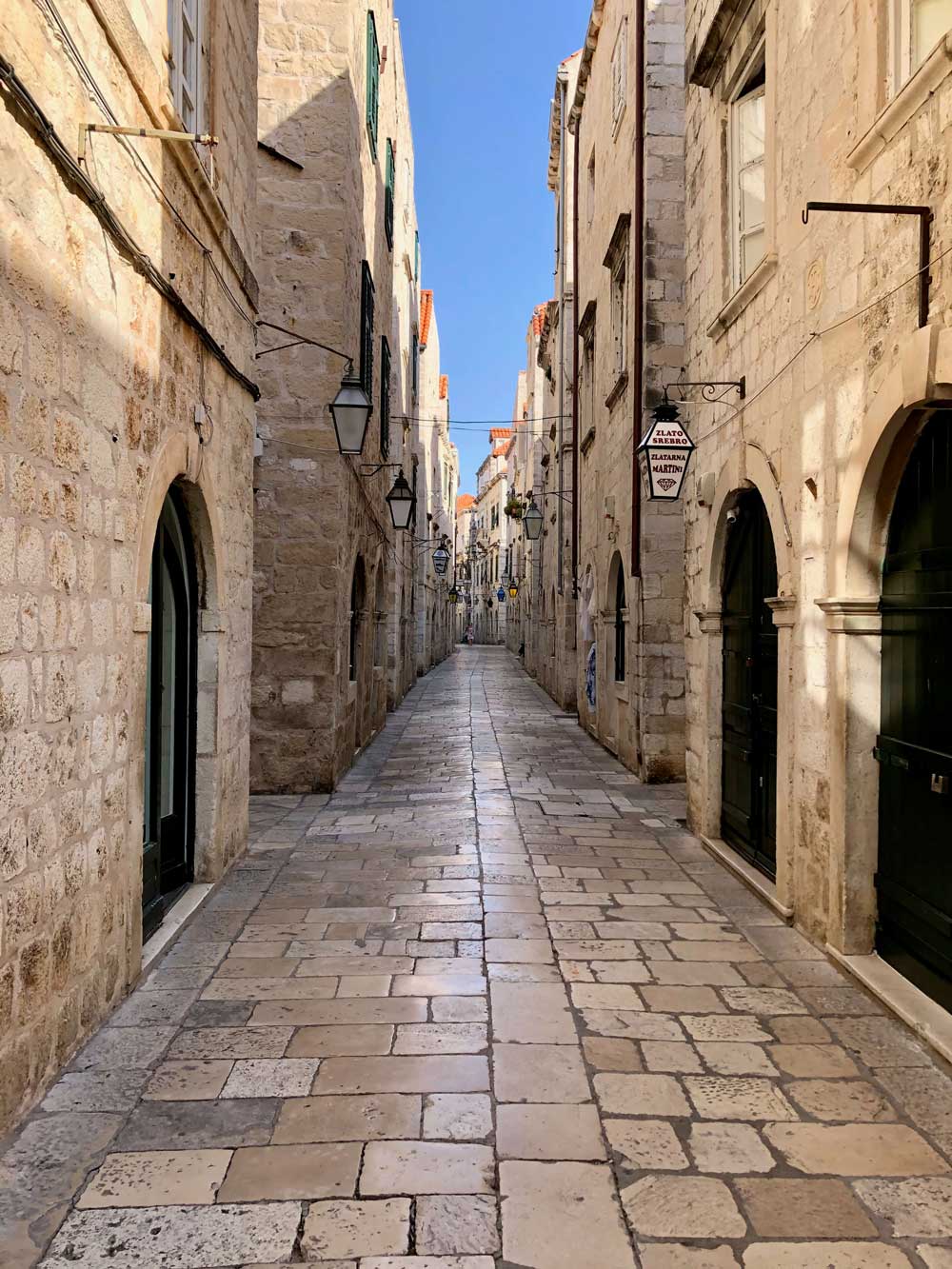Is it selfish or reckless to travel during a global pandemic? While no one has outright asked me this question, I’ve felt the silent judgement of others while talking about our recent trips to Croatia. With appropriate testing – and now vaccination – I feel that it is absolutely possible to be a responsible traveler during COVID. Croatia is the ideal COVID travel destination as being outside is a natural part of life – café bars have always had outdoor seating and dining al fresco is de rigueur in so many parts of Croatia. There are obviously additional risks and hassles associated with international travel in 2020/2021 but I’ve found it to be a worthwhile gamble. We were able to visit Split, Korcula and Dubrovnik in August 2020, we went to Zagreb in May 2021 and back to Dalmacija this July.
I received my rješenje (decision) in late 2019, informing me that my application for Croatian citizenship was approved (more to come in another post). True to character, I procrastinated on submitting my passport application until March 2020. At the time I had no clue that the application was submitted mere days before the world came grinding to a halt due to COVID. We cancelled several trips last year and I’d resigned myself to accepting that international travel was impossible for the foreseeable future. My mood rapidly changed on July 15, 2020 when I received an email from the Consul General indicating that my Croatian passport had arrived in Chicago. Colin and I were enjoying happy hour drinks two days later when I said, half-jokingly, “you know this means we can go to Croatia this year”. Perhaps my strong gin and tonics paid off as Colin didn’t resist my urge to book flights as he usually does (OK – he does typically acquiesce) and about 30 minutes later we’d cashed in points to book Lufthansa business class tickets into Split and home from Dubrovnik.
We immediately began doing our research. In 2020 I didn’t need to do anything as a Croatian citizen to go to Croatia – my passport was the magic ticket. We received conflicting information for Colin – some sources said that a translated marriage certificate would suffice while other sources said that he would need a negative PCR test. We were cautious and drove to the far western suburbs of Chicago to find a PCR test with results guaranteed in 48 hours to ensure both hurdles were met. The immigration officer in Split was initially insistent that Colin provide a negative test and, unfortunately, the airport wifi was slow to pull up his results. After a few minutes of waiting, I diplomatically pointed to my passport and our marriage certificate and asked “Mi smo u braku – je li potrebno” (we are married – is it required)? She slightly blushed, apologized, and wished us dobrodošli (welcome). We made it! Travel to Croatia is even easier in 2021 as visitors simply need to present proof of vaccination.
The US government, however, added a new requirement in 2021 – a negative COVID test is now mandatory for reentry in the US, regardless of vaccination status. Given current COVID numbers in the United States, this seems like the equivalent of offering an amputee a band-aid but we nonetheless must do this to travel. Croatia has great testing infrastructure – all major airports offer on-site testing and Zagreb even had mobile testing via an ambulance right off the main square. We’ve been fortunate to have no COVID issues on our two recent trips but it’s so easy to be outside in Croatia; the risks seem naturally mitigated by airflow and distance.
While there are certainly some additional logistical hassles to overcome, we feel so fortunate to have seen Croatia 3 times without the usual crush of tourists. The southern Dalmatian coast is typically packed with visitors in July and August. Last summer we were in Dubrovnik just as Croatia moved to the UK’s amber list and the city subsequently became a ghost town. Some evenings we wandered about and felt as though we were the only visitors in the city. Even the normally packed Stradun was empty. We were able to walk the walls in midmorning and go 10 minutes or more without seeing another soul. 2020 was truly a once-in-a-lifetime opportunity to travel.
Croatia’s economy is highly dependent upon tourism and 2021 has been much better. Zagreb in May was very quiet but we did see some small groups of visitors scattered about the city. Dalmajica rapidly bounced back this summer has approached pre-COVID levels of tourism. We started our trip in Dubrovnik and found things to be lively but still quite pleasant. We made reservations for most of our dinners but walk-ins were still happily accepted at all spots. Beaches were busier than we had expected but it was still easy to find a secluded spot. 2021 is likely the last year where peak-season Dubrovnik is so calm and relatively empty.
As we traveled north in July, things became progressively busier as Split and the nearby islands are more easily accessible by car from places like Austria, Slovenia, and Poland. Bol, on the island of Brač, is well known for the nearby Zlatni Rat (Golden Horn), one of Europe’s most iconic beaches. We chose to postpone our visit to future off-season travel as we saw upwards of 15 boats per day coming from Split and Makarska, each carrying a hundred or more daytrippers eager to see the famous beach. The rest of Bol and the interior of the island were lively but it was obvious that COVID continues to have an impact on the number of visitors. Split is the most easily accessible place we visited and it showed – the historic city inside Diocletian’s Palace was calm during the day but chaotic at night as tourists enjoyed the cooler temperatures. A 30-person deep line for ice cream suggested that tourism has returned in full force to Split. Luckily this was our second visit to the city and we were able to find neighborhood cafés, restaurants and beaches that were off the tourist circuit.
We have been very lucky to see Croatia three times since the onset of COVID and our experiences have reinforced my love for the country and its potential. During our travels in 2015, 2017, or 2019, it was rare to hear Croatian spoken on the most popular beaches of Korčula or Dubrovnik. Mass tourism had priced these places out of the budget of the average Croatian. 2020 and 2021 were different – I heard families from Zagreb and Osijek talking about how much they’d missed the coast. I sadly think the status quo will return but I’m glad these people were able to make lasting memories with their children.
We have been able to to engage with locals on a level that isn’t possible during the stress of a peak summer season. Colin and I still laugh about a 5-year-old named Diego who terrorized other Croatian kids on a beach in Korčula last summer. His beach ball started to blow away and he was in awe when Colin returned the ball to his dad with a friendly izvolite (here you go). Diego couldn’t understand why an American in Croatia during a pandemic would speak Croatian. We’ve had memorable conversations with the owners of a wine bar in Zagreb, our Airbnb hosts in Bol and Split, a former oil tanker captain turned winemaker on the island of Šipan, and so many others. These interactions couldn’t have happened in a normal year – they’d be rushing off to prepare for the next guest.
Virtually everyone we’ve spoken with on our past three trips has commented that they miss the income of a normal tourism year but they all felt that the country needed a hard reset. They worked too hard, visitors were too rushed, and it was all about quantity, not quality. That said, everyone was so grateful for the people who took a chance to travel during uncertain times. Looking back, I don’t think we would have changed a thing. There’s never a perfect time to do anything; buy a house, change jobs, etc. – and there’s always a risk. Our gamble paid off as we had some of the most impactful and rewarding experiences in more than 20 years of travel. I’d encourage anyone to carefully weigh the risks, have some contingency plans, and take the plunge. We all need a change of scenery in these challenging times.

Dubrovnik is often thought to be a victim of mass tourism but it was scarily deserted in 2020

Diocletian’s Palace was mostly empty

The ruins of Solana outside Split were absolutely deserted. We have the entire site to ourselves for over an hour.

Solana was eerie to explore when not another living soul was around



